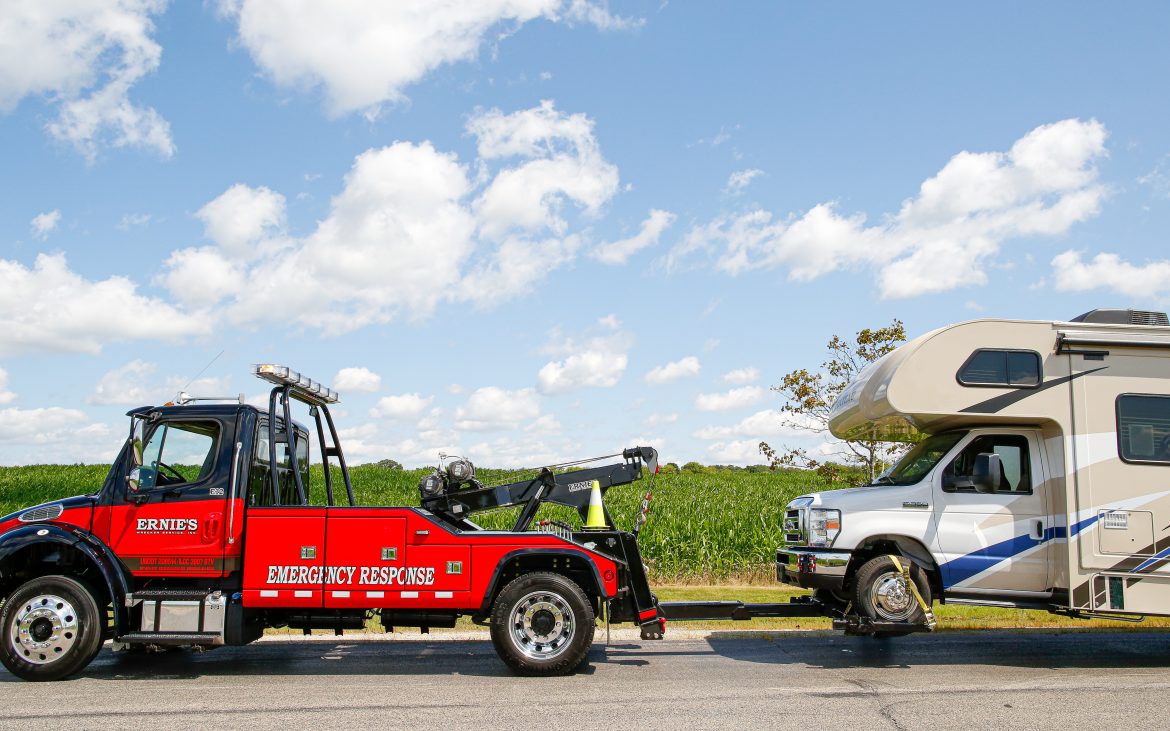Travelers everywhere fear the dreaded roadside breakdown. Aside from an injury-causing event, these are worst-case scenarios for your trip. Breakdowns interrupt plans, delay arrivals, cause reservation cancellations, put an unexpected expense into the budget, and, perhaps worst of all, add an element of the unknown to your trip.
Often with a roadside breakdown, we just don’t know just how bad it’s going to get in terms of delay, cost, repair, and hassle. Even a problem as simple as a flat tire could escalate into a bigger, more formidable issue
- If you don’t have a spare
- If the flat damages the wheel or vehicle
- If the service center doesn’t carry your tire size
- If you don’t have cell service
- If the weather is bad
- If you’re stuck in the middle of nowhere
- If you’re towing a trailer or driving an RV
And that’s just a flat tire. The more serious the reason for the breakdown, the worse the impact. For trucks, semis, and RVers, the problems can escalate when you incorporate larger vehicles and tires, towables and towing setups, additional weight, and more.
All travelers should have a plan for roadside breakdowns. The better you can prevent, predict, or quickly resolve on-the-road problems, the less danger, stress, delay, and expenses you’ll encounter.
What happens in a roadside breakdown?
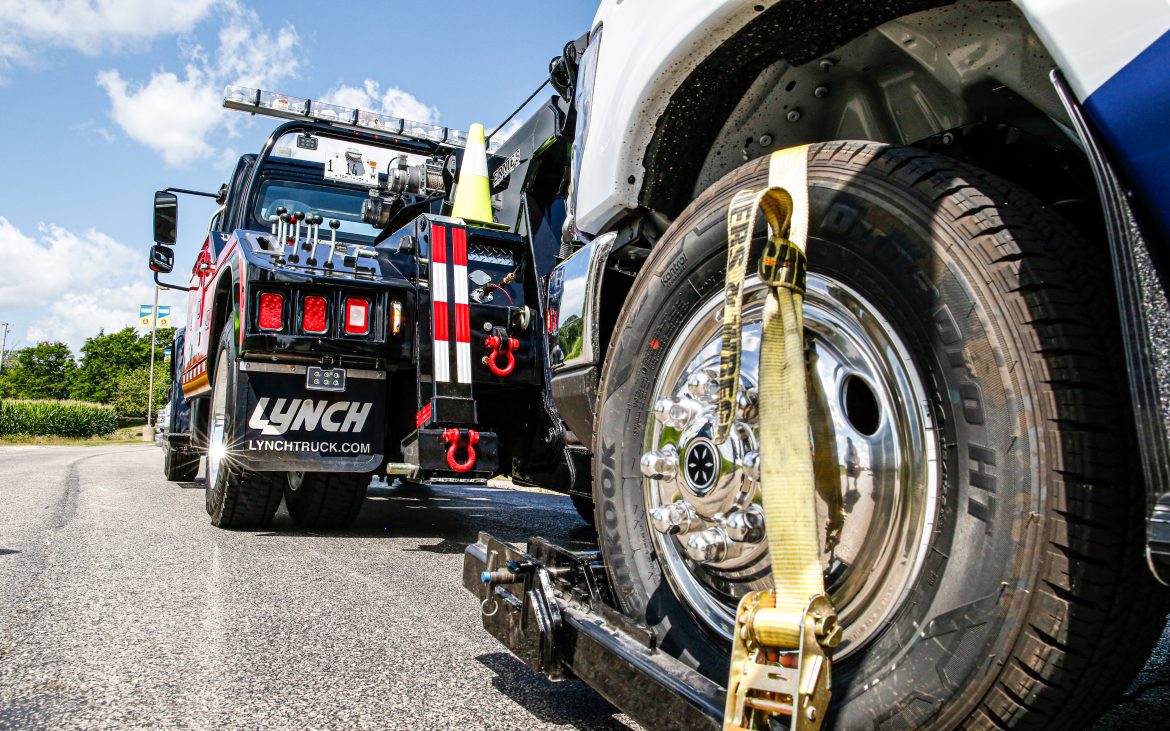
Courtesy of Good Sam
A roadside breakdown includes any incident while traveling that temporarily or permanently interrupts your trip due to a problem with your vehicle that affects its ability to operate. This could be a mechanical problem (such as an engine issue), physical damage (like a flat tire), or operator error, like running out of gas. Other reasons include problems that occur before you even leave the parking lot or house, like a dead battery.
Not all roadside breakdowns immediately put you on the side of the road or stuck. Problems with your vehicle might be less immediate than a trip-stopping flat tire. Take, for example, an engine prone to overheating. This problem could reoccur and worsen depending on conditions like traffic or hot weather. But once you’ve identified that ongoing issue, you can plan to drive safely to a service shop or a highway exit at the very least rather than end up stranded.
When any of these issues occur, you and your vehicle end up either on the side of the road or, hopefully, at a gas station, service shop, rest area, or highway exit where you have more opportunity to address the issue safely. Ultimately, where you end up will be a deciding factor in how quickly you are able to get back on the road. When on the side of the road and stranded, the process immediately becomes more expensive and more time-consuming.
How you proceed will depend largely on whether or not you are stranded and require a tow or if you are able to fix the problem at your location or safely arrive at a shop or service station. The value in having a roadside assistance plan is that, regardless of the options at hand, you don’t end up with the bill to tow your vehicle or have a mobile mechanic attempt to address the problem where it occurred.
Regardless, the first thing that should happen after a roadside breakdown is to assess the issue. Consider the following questions to take stock of your situation.
Are you and your vehicle in danger?
Your first priority should always be your immediate safety. Turn your hazard lights on right away. If you catch a flat tire or a mechanical issue occurs along a fast-moving highway without much of a shoulder and heavy traffic, consider relocating the vehicle if possible or, in extreme situations, abandoning the vehicle in lieu of finding a safer location to call for help.
Does the situation require 911?
Call 911 if there is any immediate danger to yourself or anyone’s health or safety. Provide them with your location to the best of your ability. Not every roadside issue requires 911. Use your judgment but let safety be the determining factor in deciding whether to call.
What’s the issue?
Once you are safe, take stock of the situation to determine as best as possible the extent of the problem. If it’s a flat tire, is it a puncture, blow-out, or side-wall puncture? Are there other components damaged? Are there any smells coming from the engine? Any leaking fluid? Does anything appear to be damaged? All of this will be helpful to a mechanic or roadside assistance provider trying to diagnose the problem.
What’s in your inventory to provide a solution?
Not everyone carries things like extra fuel, fluids, spare tires, or tools. But now is the time to determine what you do have in storage if you don’t know already. For example, is your spare a proper spare tire or simply a donut-style spare? Take stock of this before trips so you can better prepare and know what you have available.
If you have the knowledge, tools, and equipment to fix the issue yourself, properly ensure you have a clear and safe area to work. Consider packing and using warning triangles for this very reason, so fellow drivers are aware of your location.
Call your roadside assistance provider, auto shop, or towing company.
If you have a roadside assistance plan, now is the time to pull out your member card or find the number and figure out what your next steps look like to contact your provider. If you don’t remember signing up for a roadside assistance program, remember that some new car purchases include a roadside assistance plan for the duration of the warranty.
Think the problem may be fixable by a mechanic? Your next step, if you don’t have roadside assistance, would be to contact the closest mechanic and inquire about sending someone. But if you are positive the problem or damage is significant, consider calling a towing company to start the process sooner rather than later.
How common are roadside breakdowns?
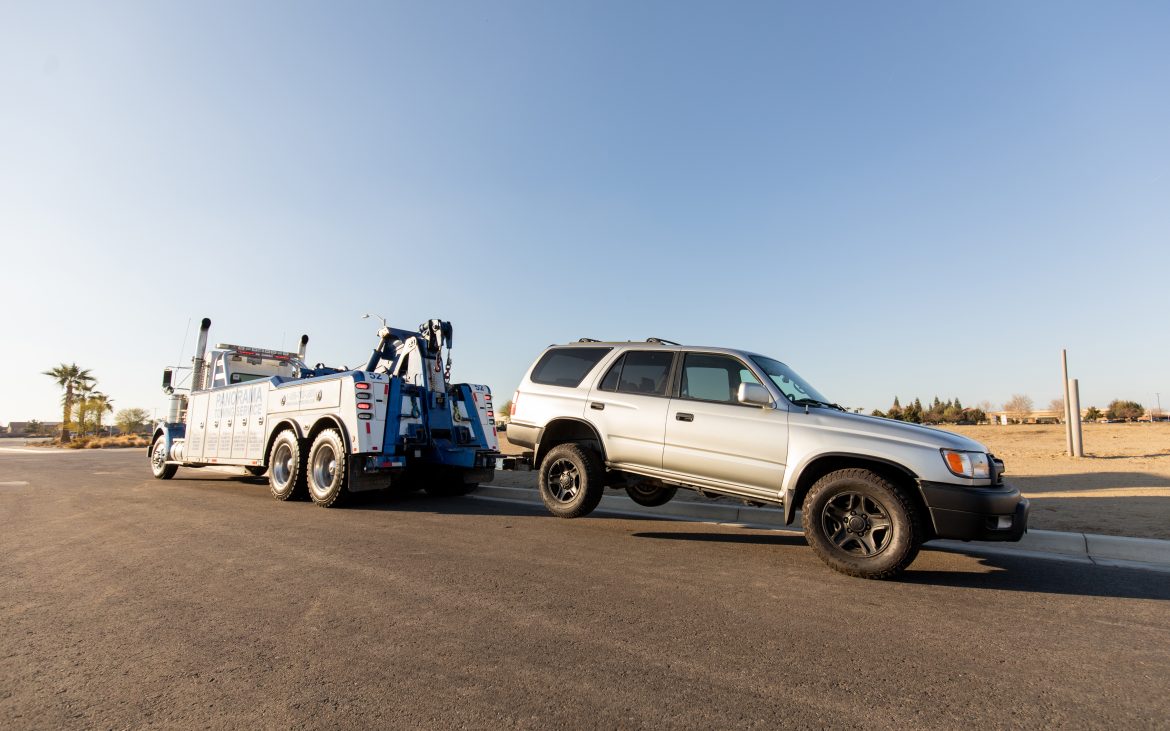
Courtesy of Good Sam
Consider your last significant road trip — any drive over three hours, say. How many roadside breakdowns do you recall witnessing? A car broke down on the side of the road, someone calling for help or receiving help, or those vehicles abandoned hours or days earlier. Someone at the campsite having trouble with their RV? Or did traffic slow because of an incident?
Likely you witnessed at least one of these examples.
Breakdowns affect everyone. New cars. Old cars. RVs, trucks, electric vehicles. Careful drivers and reckless drivers — those who adhere to the speed limit and those who don’t. But some factors will increase the likelihood of a roadside breakdown:
- Infrequent or inconsistent routine maintenance
- Driving a vehicle ten years or older (Twice as likely to have a roadside breakdown and four times as likely to need a tow)
- Balding or low-tread tires
- Extreme weather conditions such as ice, heat, or flooding
- Using an older battery or a battery that needs fluids topped off
- Worn belts
- Driving with a Check Engine light
- Continued driving after your low fuel light comes on
Keep in mind the additional likelihood that if you experience one roadside breakdown, another might soon follow. For example, if one of your tires goes flat because the tread is worn, you can bet the other three are on their way out.
What are the common causes of roadside breakdowns?

Courtesy of Good Sam
At some point in your tenure as a driver, you’ll likely face a roadside breakdown, even in a new vehicle. We’ve identified some risky behaviors and factors that can lead to a breakdown. Here we take a look at some of the most common reasons drivers end up stuck on the side of the road or at the rest stop.
Running out of gas
Running out of fuel is a serious and potentially costly problem that has recently seen an increase in incidents due to more people stretching a gallon of gas, given higher gas prices. The situation is common: you wave off a gas exit because you still have a quarter of a tank left, or you don’t realize you are low on fuel. Once you pass the exit or see your low fuel light, it’s too late. The next gas station is beyond your mileage.
Solution? Reach out for help and expect to pay the fee if you don’t have a roadside assistance plan. Or go the survivalist route and travel with extra fuel in a jerry can. This reduces your cargo space, but it buys you an out should you run out of gas.
When towing a trailer or RV, you always have to factor in the extra fuel used to pull additional weight. So when you hit the quarter of a tank line, remember you won’t get as far as you typically would when not towing several thousand pounds behind you.
Flat tires
Out of 230 million drivers on the road, 220 million flat tires occur each year. So the likelihood is high that you will experience a flat tire at some point in your tenure as a frequent driver. And it’s not all in your control. Road hazards are one of the leading causes of punctures or side-wall damage that cause flats. So even if you take proper care of your tires, you’re still at risk.
When you get a flat, you have a couple of options. Replace the tire yourself with your temporary tire (a donut), or with a spare if you have one — or call a towing service to bring you to the nearest tire shop to have the tire replaced. The question comes down to a.) whether you have a spare tire and know how to replace it, and b.
More often, new vehicles are equipped with tire inflation kits rather than spare tires, which can leave drivers in the lurch when the issue is a properly flat tire. If a new purchase doesn’t include a spare tire, consider adding one as an option.
RV tire problems
When towing or driving an RV, tire problems are exacerbated due to their size, weight, and the possibility of disrupting the suspension of your RV. If you replace a flat tire on your RV on your own on the side of the road, pay close attention to the responsiveness after driving, as unaligned tires could further damage other tires.
Overheating
Your cooling system is designed to pull heat away from the engine — an imperative function for your engine to operate safely and properly. If anything goes wrong with the cooling system, you need to stop driving immediately. The reasons for overheating are various: leaks, low coolant, blocked hoses, a broken water pump, radiator problems, low oil, worn belts and hoses, or thermostat failure.
These problems are only exasperated by hot temperatures and frequent air conditioning usage. And diagnosing the problem on the side of the road is not ideal. Left unaddressed, overheating could cause permanent damage to your vehicle. At the first sign of a problem, pull over and plan to call for assistance.
Engine problems
This category includes a variety of problems caused by something as simple as low oil to more serious issues like blown gaskets or worse. Engine problems are seldom solvable on the side of the road and are even less likely to be addressed properly without expert knowledge, tools, and equipment. This is especially true with motorhomes, semis, and diesel engines.
Brake problems
Have you ever reached an intersection with the window down only to detect a faint or considerable smell of burnt rubber? If so, your car or a car nearby may be suffering from a brake problem, either from excessive braking or a problem with your brake pads and rotor. Below are some of the other common brake-related problems that could cause a breakdown:
- A vibration in the steering wheel when braking
- A lurching to one side of the vehicle when braking
- Squealing or squeaking noises when braking at intersections
- Fluid leaking
- Unresponsive or “soft” brakes.
These symptoms are indicative of bigger problems, and it’s important you address these immediately to avoid further damage. That might mean pulling over where you are or finding a very nearby service center.
Transmission
The job of the transmission is to control the power directed toward your wheels to drive at a certain speed. Like engine problems, transmission problems will likely land you in a service shop, but some tell-tale warning signs include:
- Grinding or shaking
- Slipping of gears or trouble changing gears
- Strange noises, even when in park
- Leaking fluid beneath the vehicle that is red or dark red in color
- A burning smell
If your vehicle demonstrates any of these symptoms, your next course of action should be to get to a safe stopping place as soon as possible. Driving on a bad transmission can lead to shaking, which, at high speeds like those reached on a highway, could lead to an accident.
Low or dead battery
Battery-related trouble is common, and of all the popular DIY fixes that many drivers know, jumping another car’s battery is high on the list. Battery issues can be caused by a host of factors, but some of the leading contenders include cold or hot weather, lights left on, old batteries, and loose or corroded connections.
And battery issues are unique because, more often than not, the problem occurs prior to a drive when the engine won’t start. But when stopped at a hotel or at a rest stop, this can have the same effect as a roadside breakdown: you are stuck in a strange place without help. For battery issues that only require a jump, the best thing you can do is carry jumper cables and reach out to a friendly passerby.
Can I prevent roadside breakdowns?

Courtesy of Good Sam
A roadside breakdown may be all but inevitable over the decades, but reducing the likelihood and severity of breakdowns is within your control. And that pertains to those who drive older vehicles as well. Like your own health, the better you care for your vehicle, the less often you have problems, and you care for your vehicle with maintenance, awareness, and by having safety nets.
Preventative maintenance
Preventative maintenance includes the steps you take to catch a problem before it actualizes. The diligence of inspecting your vehicle and RV for issues, checking fluid levels, inspecting for wear and tear, and actively listening, feeling, and smelling for any changes when operating the car, truck, or RV will have a considerably positive effect in preventing roadside breakdown.
Scheduled maintenance
Oil changes, fluid replacement, tire rotation, tire changes, scheduled brake-pad replacements, filter changes, towing setup inspection — scheduled maintenance are the recommended, critical tasks that ensure our vehicles operate at their best. The problems occur when you don’t complete all preventative maintenance before an issue arises or don’t complete every recommended step. Scheduled maintenance should prevent most of your chances of experiencing a roadside breakdown.
For example, most people stay updated with oil changes but might not adhere to tire maintenance recommendations like tire rotations or balancing as often as manufacturers and dealers recommend. Staying up on scheduled maintenance improves the longevity of your vehicle.
Early detection
Similar to preventative maintenance, early detection requires that, while driving or co-piloting your vehicle, you keep a proverbial ear to the ground: observe how the road, weather, or duration of the trip might affect your vehicle. Inspect during your trip to see if any problems are occurring as a result of ongoing variables.
Roadside assistance
One of the most responsible actions you can take is to have a solution ready when a problem occurs. For travelers, that solution is roadside assistance.
Problems can occur regardless of preventative maintenance or scheduled maintenance. Having a phone number you can call that connects you with the closest, most appropriate help can mean a huge difference in the time and expense it takes to get you back on the road.
When traveling in an RV or with a travel trailer or fifth wheel, having the right roadside assistance is even more important. For towing purposes alone, the service provider that helps you during a roadside breakdown needs to understand the unique requirements of a motorhome and trailer and the tools and equipment needed. Not all towing companies, for example, own the type of tow truck that can service motorhomes.
How expensive are breakdowns?
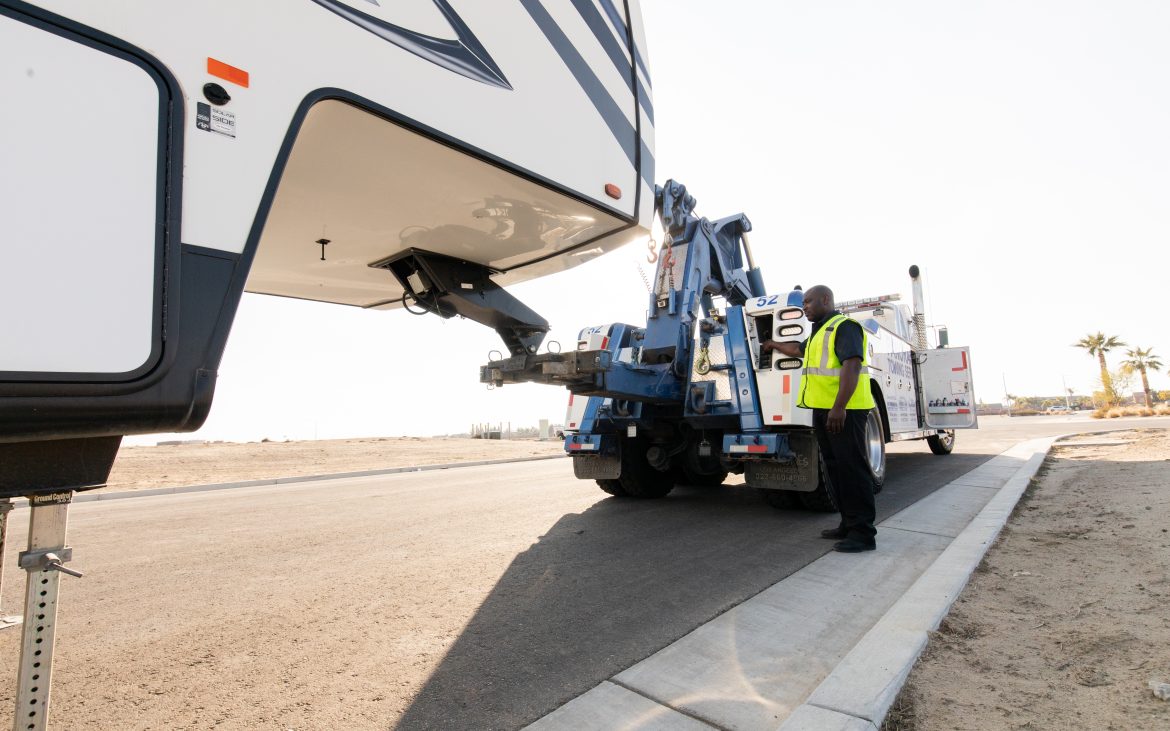
Let’s get down to brass tacks. What kind of costs are associated with a side-of-the-road breakdown? Much of the repair costs are contingent on the severity of the problem, which is no different than what you would expect when taking your vehicle in for a routine check and discovering an issue. Some repairs are far more expensive than others.
But when it comes to roadside breakdowns, the expense comes down to things like towing, having roadside assistance or not, and whether the repair is completed on the side of the road or not. For example, it costs roughly four times as much to repair something on the side of the road than it does at a shop.
Let’s explore some of these costs.
Towing
First and foremost, the cost of towing is the most variable factor in the overall expense to resolve a breakdown. Without a roadside assistance plan, the cost of towing can be substantial.
For towing, the costs will vary depending on the situation. Factors such as the ease of towing, the size and type of the vehicle, and the distance you’ll need to be driven greatly affect the price. For example, a stuck vehicle that requires the use of a winch will cost more. The national average for a regular tow comes in around $109.00 per tow. But that’s if all goes as planned: the vehicle is a standard car, the hook-up is easy, and the towing distance isn’t far. In fact, the distance you are towed is the largest factor in determining the overall cost.
Consider you will pay somewhere between $2.50 and $7.00 per mile. Those costs add up, especially if you are driving cross-country and wind up stuck in a location fifty miles or more away from the nearest tow provider. Keep in mind this is just the towing cost alone, before any work is completed to fix the actual problem.
Minor Fixes
Roadside issues don’t always require a tow or major repair, but these minor fixes can still be inconvenient, time-consuming, and expensive. How much?
Locksmith
A common service included with roadside assistance plans is emergency keyless entry if you happen to lock your keys in your vehicle. Like a breakdown, this is a headache that can easily delay your travel and add an expense. You should expect to pay between $50 and $150 to have a locksmith arrive at your location to unlock your vehicle and regain your keys.
Emergency fuel
When you run out of gas, it’s not a major request from a service op to provide a small amount of fuel to get you to the next gas station, but it’s still a cumbersome, time-consuming request, especially if you are located further from the shop.
Jump-start battery
Battery issues are common reasons for breakdowns, especially before leaving your location. A common jump-start is a fairly simple service that doesn’t require much equipment, knowledge, or time, but where you get a jump could affect the price.
For these minor fixes, you will largely be charged a flat fee or a per-mile charge. For example, a mechanic might charge $50-$100 for jump-starting a dead battery, about the same for emergency fuel, or $75-$125 for changing a flat tire, depending on how far you are from the shop.
Drivers should consider the risk, cost, and hassle of facing multiple roadside events over the years. The costs add up from just one roadside breakdown. But drivers don’t have to suffer that anxiety when such services exist as roadside assistance, designed to take away the burden and stress of potential roadside breakdowns.
What is roadside assistance?
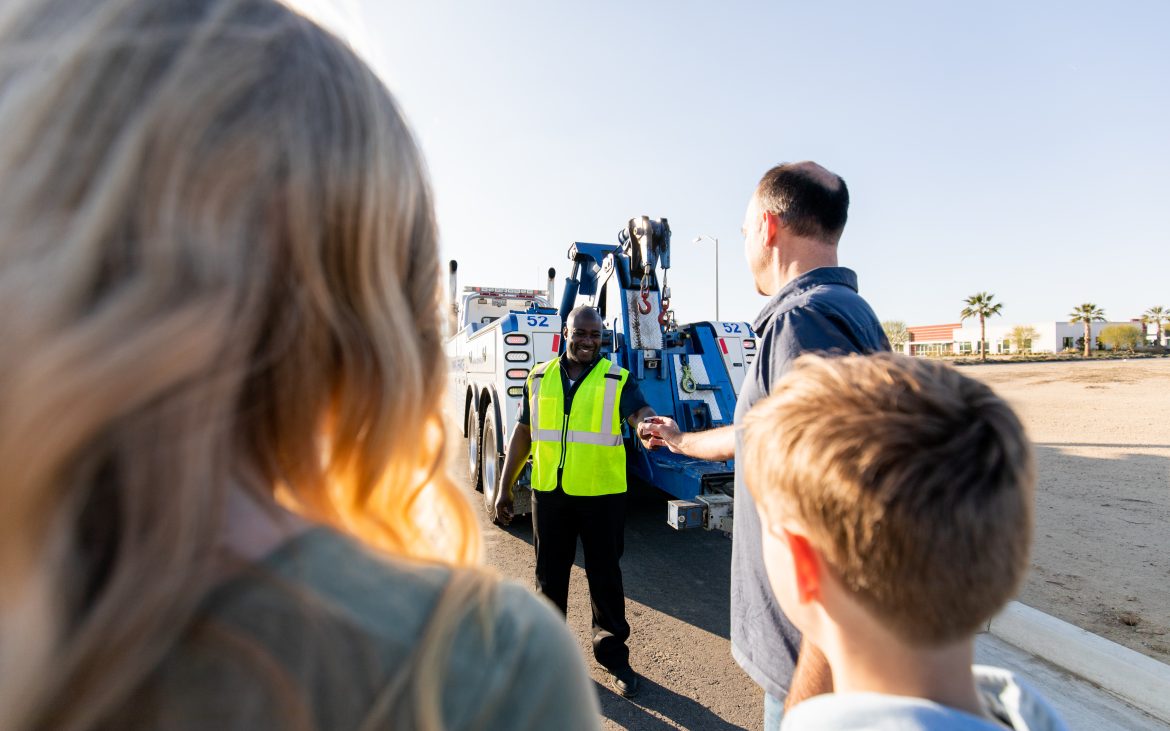
Courtesy of Good Sam
A common theme throughout any discussion on roadside breakdowns is roadside assistance. When it comes to a problem as significant, prevalent, and inevitable as roadside breakdowns, roadside assistance is the sibling solution.
Roadside assistance is an option offered to drivers that covers such emergency scenarios as discussed here. Drivers typically pay an annual fee to receive a roadside assistance plan that covers the cost and logistics of a roadside event that would otherwise leave you stranded, such issues as a flat tire, dead battery, lost or locked key, running out of fuel, or needing a tow to a service shop.
The purpose of roadside assistance is to provide you with a reliable service wherever you travel that reduces the hassle, cost, and reliability issues that are all too common when trying to find help when stranded on the side of the road. Consider, at a glance, the immediate conveniences:
- Instead of falling to the task of locating a service provider, you call a national hotline.
- Instead of haggling for a reasonable price for a specific incident, you pay an annual fee.
- Instead of wondering how much a tow will cost, you know what your plan provides.
- Instead of vetting a mechanic or towing company, your RA provider has already vetted them.
Roadside assistance plans are sometimes available through your insurance when buying a new car. Otherwise, national providers.
What does it cover?
Roadside assistance plans vary in cost, network, coverage, and type. When investigating which roadside assistance plan is best for you, consider the two main priorities: what roadside events does it cover, and what types of vehicles does it cover?
But take your inquiry a step further: How equipped is a roadside assistance provider to ensure you have help regardless of where you travel? Consider the extent of their network when choosing a roadside assistance provider.
Roadside events
Consider what all your roadside assistance plan covers and if there are any additional costs for issues that go beyond the run-of-the-mill problems. Most roadside assistance plans cover standard issues:
- Flat tire
- A lost or locked key
- Emergency fuel
- Battery jump
As discussed, these are common problems that aren’t terribly difficult to solve, but they can be a major disruption to your trip (and wallet) if you don’t have a roadside assistance plan. But when it comes to towing a vehicle, for example, roadside assistance plans change what they offer.
Find out from any roadside assistance provider what their towing policy is. Many will only cover a certain distance before charging you additionally per mile. Good Sam Roadside Assistance, for example, provides unlimited towing. And what, exactly, do you want to be able to tow in the event of a roadside breakdown? Some roadside assistance plans only cover towing for cars, SUVs, and trucks and wouldn’t cover a towable or motorhome.
Types of vehicles, types of coverage
Roadside assistance plans vary in the types of vehicles they cover. And it goes beyond cars, trucks, or RVs. What about motorcycles, trailers, sports trailers, fifth wheels, or travel trailers? Does the plan cover just your vehicle or the vehicles of your dependents and spouse?
Network
Roadside assistance providers work with towing companies, service shops, and mobile mechanics to create their service network, often nationally. And the extent of the network varies among roadside assistance providers. When choosing, identify two important features regarding their network:
- The roadside assistance provider works with reputable towing and mechanic companies
- Their network of coverage extends to the regions of the country where you plan to travel
A roadside assistance plan won’t do you much good if they can’t offer service where you travel. Take it a step further and compare the sheer number of towing companies and mechanics they include in their network. Because while a provider might offer coverage in a place like Utah, they may only have a few select companies in that area, which could lead to extreme delays when waiting for service.
Roadside assistance and accidents
If you experience an accident, your first course of action should be to ensure your immediate safety and the immediate safety of others and then call 911. Roadside assistance should never be confused with emergency response.
But what if your car is undrivable after an incident? In some cases — like when you have liability-only car insurance — you are responsible for the towing costs if your car has to be towed after an accident. But some roadside assistance programs will provide towing coverage depending on the extent of the damage and other notable concerns. Be sure to inquire with your roadside assistance provider to fully understand their coverage inclusions.
How much does roadside assistance typically cost?
For obvious reasons, plans for roadside assistance vary widely depending on the type and coverage, and you gain the ability to judge a good price once you know the main differences to look for, plan to plan. In general, plans can range anywhere from $50 a year to $200, but keep in mind the price difference often comes down to what’s provided.
For example, a $50 annual plan might only cover a certain amount of events. Or the towing distance will be limited.
A $50 plan might cover a car but won’t cover a towable, or even an SUV or truck, for example.
A $150 might sound expensive at the onset but not so much if it covers the vehicles of your spouse and dependents.
It all comes down to finding a provider that can offer a plan that meets your needs — especially if you own multiple cars or if you own an RV. Roadside assistance plans for RVs don’t have to break the bank, and they can relieve a lot of the stress that comes to first-time RV owners who aren’t as familiar with RVs as they are with their own personal vehicles.
Who offers roadside assistance, and how do I choose?

Courtesy of Good Sam
Many national roadside assistance providers offer a similar service (and price) for basic roadside assistance services. National providers are helpful because they’ve expanded their network and connections so that, with the right coverage, you can get quality, trusted help even when traveling to more remote locations. Should you experience a roadside breakdown, they will still have a reputable way to get you help.
Providers
You can find roadside assistance coverage from a host of different providers, and the main sources include:
- National providers
- Car insurance companies
- Auto clubs
- Credit card companies
- Car manufacturers
Roadside assistance is a useful product to bundle with other services, but the risk is that you aren’t getting full coverage from a company that hasn’t established a proper network.
Note that the specific services included in a roadside assistance plan can change depending on the provider you choose. Some plans include standard services like battery jumps, changing a flat tire, emergency fuel, and towing your vehicle to a service shop, while other plans may include additional services like trip interruption coverage, trip routing and planning assistance, and discounts on rental cars and other travel-related services.
When choosing a roadside assistance provider, consider the type of coverage you need and the ability of the service provider.
Coverage
When investigating which type of roadside assistance plan is best for you, identify your needs. Some big considerations might include:
- Multiple vehicles
- Trailers and towables (fifth wheels, travel trailers)
- RV or boat
- Family coverage
- Network (remote)
- Towing distance
For example, if you frequently tow a travel trailer to remote locations, make sure the provider you work with has ample ability to provide roadside assistance should you experience an issue far from a local mechanic or service shop. Inquire into such details as their ability to tow RVs, which require a different type of tow truck that some service shops do not own in their fleet.
Specialty providers
Certain roadside assistance providers are better equipped to offer help to travelers with unique needs. RV owners, for example, require a different level of attention when they experience a roadside breakdown — and even that is an overgeneralization. Motorhomes require altogether separate mechanical knowledge and equipment than travel trailers, for example.
When searching for a roadside assistance provider, make sure you find adequate coverage for your unique situation. Specialty providers understand the needs RV owners have above and beyond typical car owners, for example. If you are only concerned with your personal vehicle, shop for a provider who can offer the most extensive network, so you are fully protected wherever you go as opposed to a provider who covers multiple vehicles, specialty vehicle types, and towables.
Good Sam Roadside Assistance
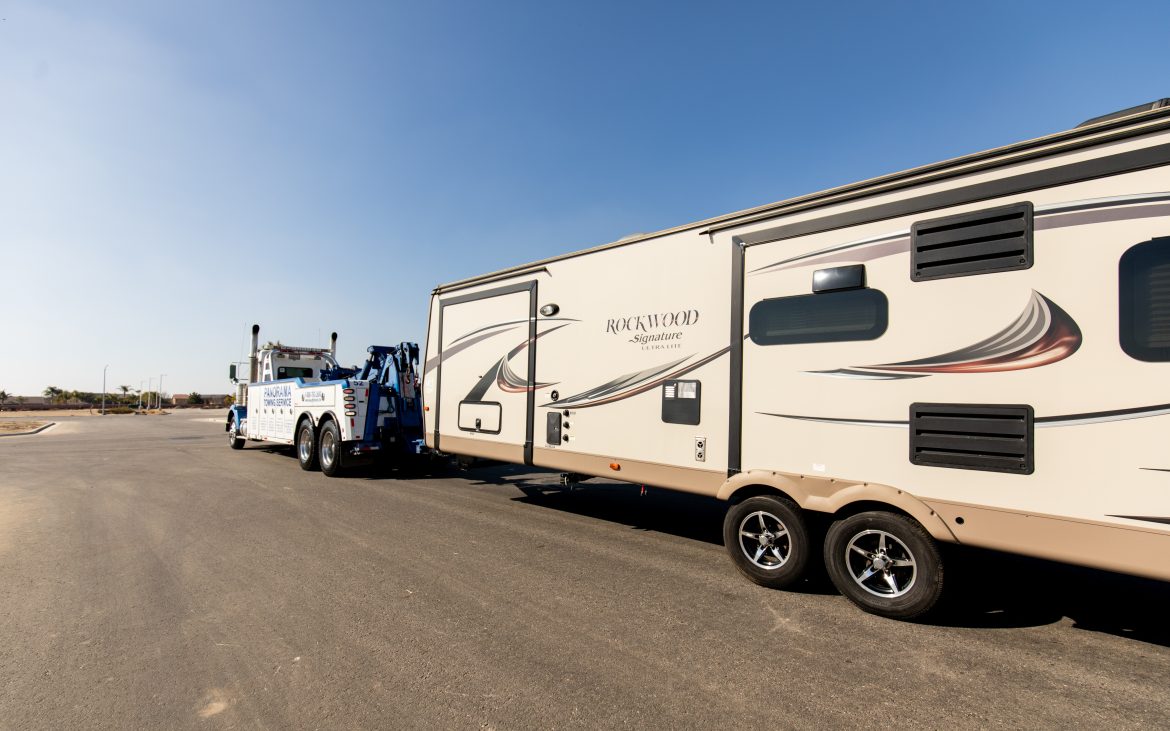
Courtesy of Good Sam
Good Sam Roadside Assistance provides multiple types of roadside assistance to help drivers only pay for what they need. Providing both auto and RV roadside assistance, they have built a nationwide network of over 30,000 service shops and towing specialists to extend help to their customers wherever they travel. Further, they offer unlimited towing distance to the nearest service shop, regardless of which plan you choose.
Learn more about Good Sam Roadside Assistance plans.
Good Sam has been helping travelers and RVers across the country since 1966, and many plans in their roadside assistance coverage offerings are designed to ensure RVers receive the important, unique coverage they need wherever they travel, especially when experiencing a roadside breakdown. Plans cover such items as trailers, camper vans, travel trailers, fifth wheels, toy haulers, motorhomes, and more.
To learn more about Good Sam Roadside Assistance and the services they provide, check out these helpful roadside assistance resources that further explore their offerings and other relevant topics relating to staying safe on the road.

